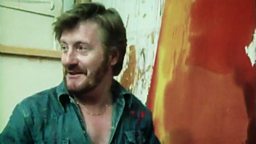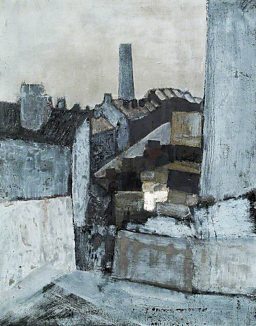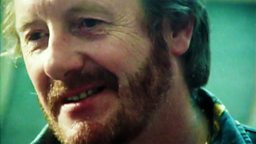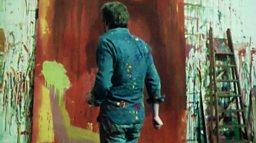Art Rebel: Too abstract for the Royal Academy
10 September 2014
When I first saw Mondrian there was nobody could convince me it wasn’t a table clothJohn Hoyland
As a student, abstract painter John Hoyland had his work dismissed as too racy and rebellious for the Royal Academy, before going on to be a Royal Academician at the heart of the British art establishment.
London's Royal Academy of Arts was not swift in embracing abstract painting. In truth many Academicians both before and after the Second World War were strongly opposed to modernism in all its forms.
Few felt this antipathy more keenly than the British painter John Hoyland, who was a student at the Royal Academy Schools between 1956 and 1960.
Hoyland became the first student to submit abstract works for the diploma presentation that sealed a student's graduation from the Academy. He then suffered the ignominy of seeing his paintings taken down on the direct order of the President of the Academy, Sir Charles Wheeler, who objected to the very presence of abstract paintings in the Schools.
Hoyland had arrived at the Schools as a painter of landscapes and cityscapes. In an interview given in 2004 Hoyland reflected on his progression towards an abstract practice.
"I knew nothing about anything at all. I'd come from Sheffield where they taught Renaissance drawing. I learnt to fake it, but I wasn’t very good."
“When I first saw Mondrian there was nobody could convince me it wasn't a table cloth – just nobody could, I just didn’t get it. And then I heard that Bill Turnbull was a great teacher and he did this evening class at the Central School. So I went and enrolled on it while I was at the Academy.”

The artist William Turnbull had been to New York and become a friend of painters such as Mark Rothko and Barnett Newman. His experiences and beliefs had a great impact on the young Hoyland.
I used to make sure I got on the same bus as Turnbull and plug him all the way home because he’d been to America and met Rothko
"I used to make sure I got on the same bus as him and plug him all the way home because he’d been to America and met Rothko and people. I was soaking it in. Poor devil, he couldn't get away from me."
Although the Schools provided a supportive environment, Hoyland continued to look elsewhere for the guidance he felt he needed, including one of the country’s most influential abstract artists, Victor Pasmore.
"I heard about this course in Scarborough. I think it was a week's course or something. It was Victor Pasmore and Harry Thubron and a guy called Tom Hudson. I was feeling my way intuitively, but half an hour conversation with Pasmore sorted me out, it was just brilliant. And then of course I went full steam ahead."
Although Wheeler ordered his abstracts off the walls, Hoyland still graduated thanks to the support of the painter Peter Greenham, who was the Keeper of the Academy, responsible for the RA Schools.
"Peter Greenham was marvellous. He pointed out that the Academy had bought a small grey, rather De Stijl-like painting called Back Yards Sheffield and... I was just old enough to be allowed to experiment. And so I was given my piece of paper, but they couldn’t take the work."
Hoyland went on to become one of Britain's foremost abstract painters. Despite his treatment by the RA as a student, he accepted membership of the Royal Academy in 1991 and his career was celebrated with a major Academy retrospective in 1999.

John Hoyland

-
![]()
John Hoyland at Your Paintings
Watch a slideshow of paintings by abstract artist John Hoyland.

Abstract Art archive collection
-
![]()
Artists on Film
A focus on abstract artists, including William Hayter, Patrick Heron, Victor Pasmore, John Hoyland and Anthony Caro.
-
![]()
Six Days in September
First shown in 1979, Arena profiles John Hoyland, seen by many as England's finest abstract painter.
Abstraction
-
![]()
Exclusive features
When Art Broke Free: explore one of art's most groundbreaking forms with a season of special programmes, unique archive, and exclusive online content including films, features & timelines.
Abstraction
-
![]()
Exclusive features
When Art Broke Free: explore one of art's most groundbreaking forms with a season of special programmes, unique archive, and exclusive online content including films, features & timelines.
Art and Artists: Highlights
-
![]()
Ai Weiwei at the RA
The refugee artist with worldwide status comes to London's Royal Academy
-
![]()
BBC Four Goes Pop!
A week-long celebration of Pop Art across BBC Four, radio and online
-
![]()
Bernat Klein and Kwang Young Chun
Edinburgh’s Dovecot Gallery is hosting two major exhibitions as part of the 2015 Edinburgh Art Festival
-
![]()
Shooting stars: Lost photographs of Audrey Hepburn
An astounding photographic collection by 'Speedy George' Douglas
-
![]()
Meccano for grown-ups: Anthony Caro in Yorkshire
A sculptural mystery tour which takes in several of Britain’s finest galleries
-
![]()
The mysterious world of MC Escher
Just who was the man behind some of the most memorable artworks of the last century?
-
![]()
Crisis, conflict... and coffee
The extraordinary work of award-winning American photojournalist Steve McCurry
-
![]()
Barbara Hepworth: A landscape of her own
A major Tate retrospective of the British sculptor, and the dedicated museums in Yorkshire and Cornwall
Art and Artists
-
![]()
Homepage
The latest art and artist features, news stories, events and more from BBC Arts
-
![]()
A-Z of features
From Ackroyd and Blake to Warhol and Watt. Explore our Art and Artists features.
-
![]()
Video collection
From old Masters to modern art. Find clips of the important artists and their work















